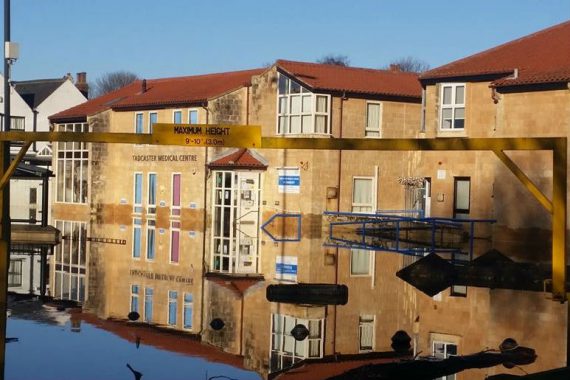I was spending Christmas with family in Scotland and so fairly oblivious to the adverse weather conditions affecting Yorkshire on Boxing Day. But around 5pm I received a text from a colleague – ‘Need anything from your room, just in case?’
Our practice building in Tadcaster was opened in 1991. Even in the floods of 2000 and 2013 we had never had a drop of water over the doorstep. We had been unable to open one day in 2013 because of the flooding in the car park. But this time was different. Around 10pm, the shops over the other side of the bridge were clearly flooded, with water up to the letterboxes. We’d be ok though, wouldn’t we?
At 11.45pm I received a photo that suggested we wouldn’t. The pub next door to the practice was now surrounded with water. That was as close as anyone was able to get. We just had to wait.
The next day, Sunday, a beautiful photograph taken by a drone confirmed our worst suspicions: the practice was surrounded with water. Despite our elevated position from the car park, we had water up to the window levels at the front of the building. Levels were starting to fall but the damage was done.

Sadly, the damage inflicted by 24 hours and two feet of water will take longer than two weeks to repair
This time of crisis strengthened the community spirit in the North Yorkshire town. An army of volunteers, both local and from further afield, descended to flood-hit properties in the town on the Monday morning. Over 40 people donned their wellies and rubber gloves to clear mud from the building, rip up carpets and empty out furniture. They could have been relaxing, eating the last of the turkey leftovers and enjoying the Christmas TV but they came to help us.
We had lost all our vaccines in the power cut along with supplies of dressings, dispensary stock, equipment, furniture and paperwork. Nevertheless, we had to remember it was only work and not our home, unlike many of our patients who had lost whole parts of their lives and memories in the flooding. We also had no computer access despite the valiant effort of the CSU staff, who came in on their day off to try to get things up and running.
Historically, the days between Christmas and the New Year are always very busy – how would we cope?
Luckily, there was a plan, although it hadn’t banked on the York BT exchange being flooded meaning that we weren’t the only practice without normal phone lines. On 29 and 30 December we managed to run our service with the help of four neighbouring practices, who welcomed us into their surgeries. And do you know, it was oddly quiet – not the usual post Christmas rush. We had the added problem of the partial collapse of the only foot and road bridge crossing the river in Tadcaster, making a journey that usually takes a few minutes a 30-minute, 20 mile round trip on the busy dual carriageway.
But we felt we needed to be ‘back home’ at the medical centre and so on New Years Eve we reopened the surgery. We had our IT systems back up and a slightly temperamental phone line. We also secured the use of a small consultation room at one of the pharmacies on the other side of the bridge, enabling us to see people who had no means of getting around the long diversion. And it felt good to be able to see them, back in my comfort zone of patient care.
Using our website, social media and local radio stations helped us to spread the word about what was happening. We were able to publicise that we were open and to use the usual phone number. We also found out that CQC, who had inspected us earlier in the year, had been monitoring the situation and were impressed by the way we had been able to keep the service running and keep patients informed.
So are we all back to normal? Not yet. Sadly, the damage inflicted by 24 hours and two feet of water will take longer than two weeks to repair. Luckily we are insured. There will be a claim for in excess of £100,000. We have been told all the ground floor plasterwork is 100% saturated and will need to come off to about a metre in height. The floors all need replacing. We can only use one staircase as the other has steps that are unsafe. If we are lucky, we will be able to keep working in the surgery whilst the work is undertaken, although we have to look at portakabins and are hot desking in the more usable consultation rooms. Optimistically this process will to take around 6-9 months to complete. And the Tadcaster Bridge will take longer, up to 12 months and £3m. We are optimistic there will be a temporary footbridge to reconnect the east and west sides of the town soon. So our visits will continue to take us for a drive around the Yorkshire countryside until there is an accessible route for vehicles again.
But I could not work in a more supportive practice. A special mention has to go to our manager who not only had her whole family helping out but has taken on the monumental task of liaising and coordinating all the relevant parties, enabling us doctors to be doctors and focus on patients and their ongoing care. Thank you all, you are amazing.
Dr Alison Pitt is a GP partner at Tadcaster medical centre, North Yorkshire

















